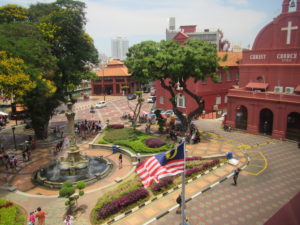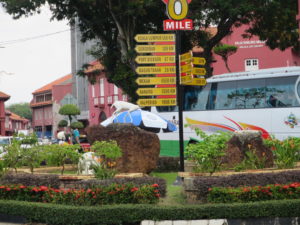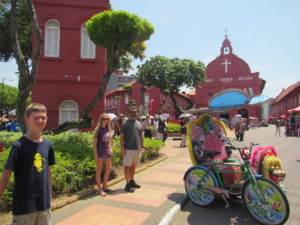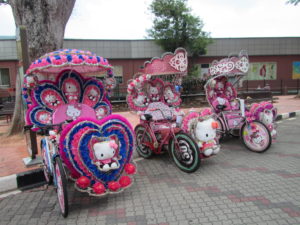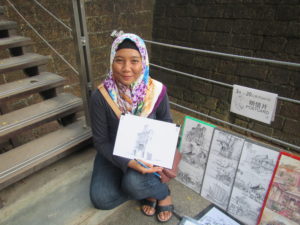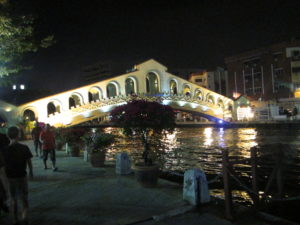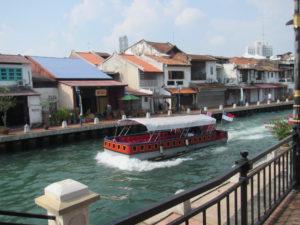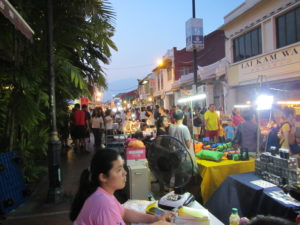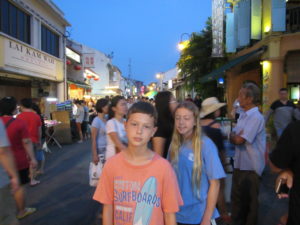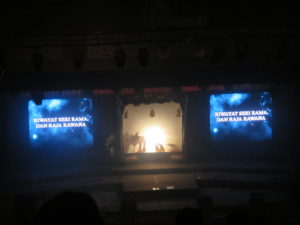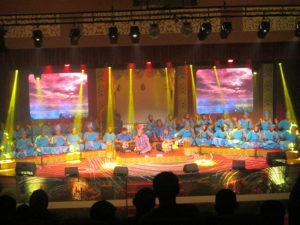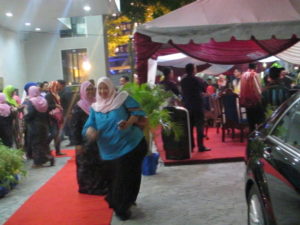We visited a few places in Malaysia: Melaka and Kuala Lumpur. We traveled to Melaka (or Malacca) from Singapore via bus. The bus stopped at both borders so we could clear out and in of the countries. Luckily, it wasn’t a very long bus ride, and then we were in a new country.
We had arranged a hotel for a night to get the lay of the land, but after staying there, we realized it felt just a bit out of the historical area–which was much more desirable. We moved to a cheap place within the historic district. This turned out to be our most basic accommodation in all of SE Asia. I wasn’t in love with the hotel, but the town sure was pretty. It has been a UNESCO World Heritage Site since 2008, so it has a great bit of history and many tourists (see the end of this Melaka/Malacca post for a brief history!). Here are some pics of Melaka:
The center of town
The fascination with “Hello Kitty”
The Artist we Bought Some Drawings From:
Melaka is situated on a river, (Melaka or Malacca River), which runs through the center of town.
The river during the day
Melaka has a weekly street fair (on Jonker Street) with lots of kiosks selling food and trinkets, as well as some people singing really terribly. That was amusing to watch. They also had “ice cream puffs” and the kids and I indulged in those as well. It made the singing more tolerable.
The Kids and I exploring Jonker Street while Dan took a nap…Ryan looks enthused!
One day we went to Stadthuys Museum. That provided a lot of the history of the town. Another day, we went on a tour with the visitor’s center, and we climbed St. Paul’s Hill and toured the old church. We also learned about Melaka’s slogan which is: “Don’t Mess with Melaka.” You recognize that slogan, right? Our very own Texas? Apparently, it is a copycat slogan, but it refers to the littering problem Melaka has. We also saw an old Chrysler (probably 1950s) that is near the town square, with a fence around it. Our tour guide challenged us to figure out how you put the gas into the car. There were no obvious places. He told us the answer, and now I can’t remember. Shoot. Foggy memories. Maybe the kids will remember. Do you know the answer to this?
Here is the car:
One of the more memorable experiences in SE Asia was in Melaka. We found a flyer for an annual event taking place in Melaka while we were going to be there. It was a cultural event called: “Wayang Kulit & Dikir Barat selat.” It looked interesting, so we planned to go to it the next night (Friday). Come Friday, we decided to don our long skirts, pants, and shirts that covered our shoulders and head over to the festival in a “Lyft” (similar to Uber). It was supposed to cost roughly $25 for the whole family (given the favorable exchange rate). Well, we arrived, and people looked at us perplexed. The owner of the venue came to talk to us, asking us all sorts of questions about how we found out about the event, why we were interested in going, etc. These weren’t aggressive questions; he was just full of curiosity and surprise. We found out why! First of all, this was a celebration of the Muslim community, and we didn’t look much like Muslims. Secondly, it was the “premiere” night; the governor was attending, and the tickets were EACH equivalent to $25, not $25 total. The next night (Saturday) was the less expensive night. So, the venue’s owner was just perplexed about what to do with us. We had told him we found the flyer and thought it would be interesting to attend and learn more about the culture. We CLEARLY did not “fit in” but the owner of the venue was so incredibly accommodating. He said he would honor the price on the flyer, and that we were more than welcome to attend, although it would have to be on the second level. He also said they were having a reception after the event, and that we were welcome to join them. How nice was that! I am not so sure, if the shoe were on the other foot here in the U.S., that most people would have been as accommodating. We got to our seats and received LOTS of looks from the school children in attendance (who were also on the second level with us). They were so full of smiles but obviously surprised to see us there! Also, everyone except two women (who happened to be seated in front of us) was wearing a head scarf. These two women (a mom and a daughter) spoke excellent English and were obviously very classy, educated women. They too were curious why we were interested in attending, but also welcoming. We could see the governor sitting in the mezzanine level as well.
The first part of the performance was an older man doing puppetry behind lights that then this was magnified on the large screen (shadow puppetry). (See below.) This was a bit boring to us who spoke no Malaysian, but there was some laughter in the crowd. Ariana made up a story in her own mind as it was playing out, to keep herself entertained. The next part was more exciting; it reminded me of Bollywood!
The old puppet master!
There was a lot of singing and dancing in colorful costumes. It truly was beautiful! By the way, there is no drinking in the Muslim community so although some stores sell alcohol, Muslim people are not permitted to purchase it. This reception was also dry. (This is NOT why we decided not to attend though!) Truth be told, we did feel a bit like fish out of water at the event, but isn’t that what travel is all about? So, we learned more about the Malaysian Muslim Culture by participating in the event, but I also didn’t want to make anyone feel like we were hoarding in on the free food, so we opted to explore the town more after the show. The whole evening was a bit surreal though. We were welcomed in, despite what the Malaysians undoubtedly have heard about Americans’ attitudes toward Muslims. (Interestingly, most people worldwide know a lot about what’s going on in the U.S.) I am so glad we went…
The Reception afterwards
After a handful of days, we were headed out of town and to a bigger city, which, if I recall correctly, we reached by bus again. Kuala Lumpur!!
(Melaka History from: https://www.tripsavvy.com/malaccas-history-influences-the-present-1629516
“Present-day Malacca in the nation of Malaysia reflects its tumultuous history – a multi-racial population of Malays, Indians, and Chinese call this historic city home. Most notably, Peranakan and Portuguese communities still thrive in Malacca, a reminder of the state’s long experience with trading and colonization. Malacca’s founder, the ex-pirate Prince Parameswara, was said to be a descendant of Alexander the Great, but it’s more likely that he was a Hindu political refugee from Sumatra.
According to legend, the Prince was resting one day under an Indian gooseberry tree (also known as a melaka). As he watched one of his hunting dogs trying to bring down a mouse deer, it occurred to him that the deer shared a similar plight to his own: alone, exiled in a foreign land and surrounded by enemies. The mouse deer then achieved the improbable and fought off the dog.
Parameswara decided that the place where he was sitting was a propitious one for the disadvantaged to triumph, so decided to build a house on the spot.
Malacca did indeed turn out to be a favorable place to found a town, due to its sheltered harbor, its abundant water supply and its prime location relative to the regional trade and monsoon wind patterns.
Melaka and the Chinese
In 1405 an ambassador of the Chinese Ming Empire, the eunuch admiral Cheng Ho (or Zheng He), sailed into harbour with a huge armada of giant trading ships.
Ho started a mutually beneficial trade partnership, which eventually culminated in Malacca agreeing to become a client kingdom of the Chinese in exchange for protection against the Siamese.
After its adoption of Islam in the 15th century and conversion into a sultanate, the town started to attract traders from the Middle East, swelling the ranks of those already arriving from every seafaring nation in Asia.
Malacca and the Europeans
Soon after, the covetous eyes of the emerging European naval powers fell on the wealthy little nation. The Portuguese, who arrived in 1509, were at first welcomed as trading partners, but then expelled when their designs on the country became apparent.
Miffed at being rebuffed, the Portuguese returned two years later, seized the city and then attempted to turn it into an impregnable fortress, bristling with seventy cannon and equipped with all the latest anti-siege war technologies. These, however, proved insufficient to keep out the Dutch, who starved the city into submission in 1641 after a six month siege, during which the residents were reduced to eating cats, then rats and then finally each other.
When Holland was overrun by the French in the Napoleonic wars, the Dutch Prince of Orange ordered all his overseas possessions to surrender to the British.
After the wars ended the British handed Malacca back to the Dutch, then shortly afterwards managed to regain the city by swapping one of their Sumatran colonies for it. Apart from a brief tenure by the Japanese during WW2, the city stayed in British hands until Malaysia declared independence, here in Malacca, in 1957.
Malacca Today
All these disparate traders and invaders intermarried, resulting in the ethnic and cultural diversity which now make Malacca a UNESCO World Heritage site, such a fascinating place to visit and also, for the non-culturally-curious partners of the many culture vultures who flock to the city, also a delicious one in which to eat.
You get a sense of a quainter age as you meander round the old streets, an age where gentlemen wore white suits and pith helmets and briskly swung rattan walking sticks as they walked to their clubs for a snifter of gin. The rattan canes often swung a little less steadily on the way home, their owners having enjoyed a measure or two more than sobriety allowed – these were, however, easily justified as being essential for the health, due to the gin’s supposedly prophylactic properties.
